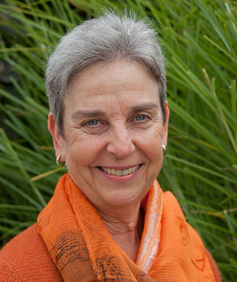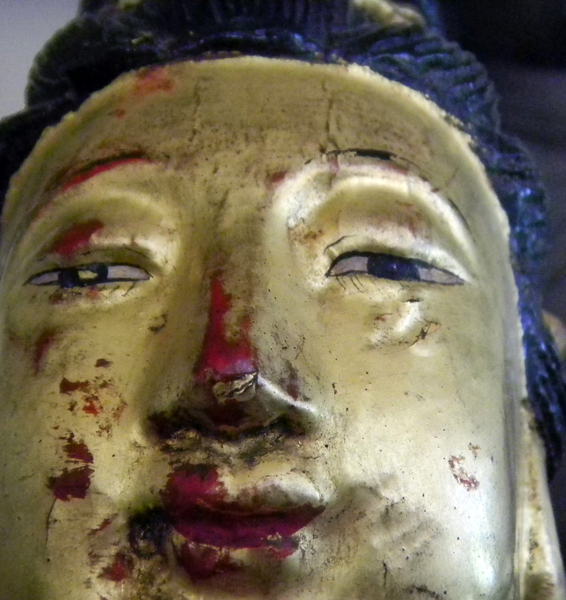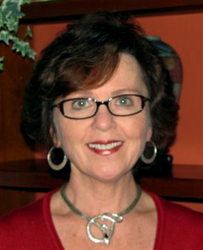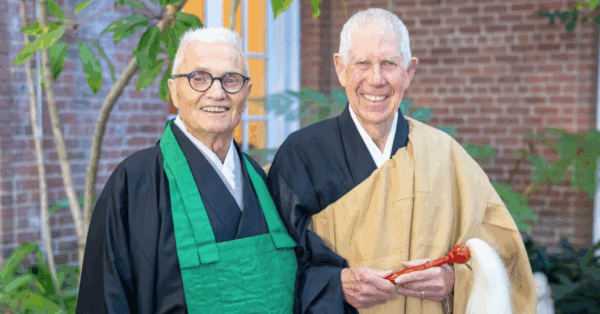by Jay Pennington
Fight, flight or freeze? When it comes to handling stress, at the most basic level I have more in common with a wild animal than I tend to think—and this is actually good news. It’s always grounding to talk with my friend Jane Lazar and be reminded of that, especially when she discusses her work helping people heal from trauma. Key to accessing natural stress-relieving tools, I’ve learned from Jane, is the capacity to be in the present and in the body.
A Zen priest and alumnus of San Francisco Zen Center, Jane Lazar is also a certified practitioner of Somatic Experiencing® (SE), a therapeutic method for coping with stress and trauma that was developed by Dr. Peter Levine. The method is based on the observation that animals in the wild have an innate ability to recover from threatening experiences without becoming traumatized, and that humans have this same capacity, if we only learn how to tap into it.
Jane shares her somatic skills in her private practice in North Berkeley as well as through workshops at Zen Center, which are often co-led with Patricia Meadows, SEP: Finding Balance: A Somatic Approach to Meeting Trauma Mindfully and Skillfully is a two-day version, and Meeting Trauma and Finding Balance: A Somatic Approach to Spiritual Practice, is a single-day workshop (follow links for dates).
Her responses to a few questions below explain more about SE and trauma, including some of the fascinating theory behind it, as well as her own experiences as both client and practitioner.
Would you clarify just how troubled we need to be to benefit from your type of work? On your website, I read about “trauma” and “perceived threats to life,” right alongside the much more mediocre-sounding terms “accumulated stress” and “overwhelm.” How much of the ubiquitous stress and overwhelm in our modern world can be traced back to an event deemed as life threatening?
Well, Jay, I think someone who is not troubled at all could benefit from this kind of work! When we are not aware of our somatic (bodily) experience, we often skip right over pleasant, positive experience. This work allows us to slow down and deepen into it, tapping into a richness, even a wisdom, in the depth. But I know you want to talk about stress and trauma, so here we go.
I’ll start out with two brief points. First, stress and trauma are not synonymous; you can think of them as being on a continuum. Second, trauma is in the nervous system, not in the event. The same event might result in traumatic symptoms for one person and not for another.
That said, the skills for calming or self-regulating that we teach work just as effectively with common stress as they do with trauma. And it doesn’t always take a big event to habituate the nervous system to overwhelm or high activation. Small events can be cumulative in forming symptoms of trauma if we don’t have the skills to come back to regulation in between.
![When not processed properly, trauma can result in a recurring pattern of reactions to stress that run outside of the normal range experienced in a healthy nervous system. Jane and Patricia explain more in the workshop about these graphs from the Somatic Experiencing Trauma Institute’s website. [http://www.traumahealing.com/somatic-experiencing/]](https://blogs.sfzc.org/wp-content/uploads/2014/08/graphcombovert.jpg)
When not processed properly, trauma can result in a recurring pattern of reactions to stress that run outside of the normal range experienced in a healthy nervous system. Jane and Patricia explain more in the workshop about these graphs from the website of the Somatic Experiencing Trauma Institute.
But as we know, ideal conditions rarely occur, and there are infinite possibilities for young nervous systems to be overwhelmed. From the time we are in utero, our brains and nervous systems are affected by the state of our mothers and family, the birth process, medical procedures, how we are attended to emotionally, social and cultural conditions such as war, falls, accidents—you name it.
While we have the sympathetic (or gas pedal) element of the ANS already online when we are born, the parasympathetic response is something we need to learn from our caregivers, and that’s what allows us to come down from alarm back into calm, settled well-being. If our caregivers are highly anxious or disregulated, our systems may not learn how to self-soothe.
Or, because frequently little ones cannot successfully enact fight/flight (an infant cannot run away), the only option for escape from intolerable pain or terror is the involuntary freeze response. That freeze is a physiological state and can become a default pattern later in life.
At the very least these early situations leave us more vulnerable and more reactive to later stress and trauma.
One reason I use the terms “accumulated stress” and “overwhelm” is that most people don’t relate to the term “trauma” unless they have had an incident that is obviously traumatic—a car crash, a rape—what we call “shock trauma.” For many people, trauma can be developmental—situations with caregivers and family that were abusive or hindered healthy and full development.
Culturally we are just now becoming literate about trauma. It was only in 1980 that post-traumatic stress syndrome (PTSD) entered the DSM-III (the Diagnostic and Statistical Manual of Mental Disorders, which is used by psychotherapists) as a diagnosis, with continual updates as more has been discovered. And it is only since May of 2013 that PTSD has become a diagnosis for children under six, with the release of the DMS-V.
In a dharma talk at City Center some time ago, I recall how you described your own discovery of unreleased trauma at some point after many years of practice at Zen Center. How did you discover it, and what did you do about it?
It was after three or four years of practice, two of which were at Tassajara where I practiced intensively. I found that during sesshins [multi-day sittings], and sometimes even in morning sittings, I would slide into deep, dark emotional places and couldn’t get myself out. I would cry uncontrollably. I remember one time, during a Tassajara sesshin, we got up for morning service and tears were rolling down my face through all nine bows.
I talked to many teachers over those first years. With one exception, I was basically advised to keep sitting. I saw people loving zazen, so I didn’t think others were going through the distress that I was. I thought, “Something is wrong!” And eventually, the thought arrived, seemingly out of the blue, “I think I have unresolved trauma.”
The first person I spoke to about this advised me to read Peter Levine’s Waking the Tiger. As soon as I read about the freeze response, I knew instantly that’s where I had been living my life from. And I knew I would explore Somatic Experiencing® as a client. About six months later I began.
I learned the very skills I now teach in this workshop and to my clients and still practice myself. I brought them into my zazen practice. Some of my experiences doing that were real turnarounds for me.
One time, I had just incurred a major hurt in relation to someone in a position of authority. As I sat that morning, my distress began to increase, and then I remembered the skills. I looked for some piece of my current experience that was pleasant, and I found the warmth around my legs covered by silk long underwear, and then my soft robes, in the cold zendo. I intentionally focused on the warm and soft sensations in my legs. I felt my system calm down. Amazingly, I calmed all the way into a sense of well-being and expansion. As I thought of that person again, my heart seemed to expand also. I realized how much pain she must be in. I felt compassion, though I hadn’t been trying for that. I remember walking out of the zendo with an image of putting my arm around her—really different than where I would have been without those skills.
Still, sometimes sesshins could be too much for me. In my last years at Green Gulch, I made an arrangement with my teacher that if I got “disregulated” during a sesshin, I could leave the zendo and go to my cottage until I could regulate myself, which I always could, lying on my bed, looking out at the beautiful trees, feeling the warmth of the blankets and the soft support of the futon under me, feeling my physiology shift. I would come back to myself and then I would come back to the zendo. I wish I’d had the courage to ask for that much earlier.
By the way, I believe the Buddha was aware of the need to sometimes consciously shift out of dark places. It’s one thing to be present with the dark and difficult. I’m all for that. But it’s another to get pulled in and overwhelmed by those places. Not helpful. Re-traumatizing. Strengthens those neural pathways. In the Majjhima Nikaya Sutta #20, the Buddha articulates this intentional shift. In SE we call it pendulating. In iRest Yoga Nidra, it is called the use of opposites.
As you just alluded to, you’ve explored a lot of interesting holistic practices over the years, from zazen to SE and iRest Yoga Nidra to Aikido. Is there some commonality among these practices that attracted you, or that you now feel is a uniting aspect of them all?
Yes (and I’d add Nonviolent Communication, as taught by Marshall Rosenberg, to that list). They all are practices of being in the present moment, being connected to the senses and the environment (whether internal or external), being connected to oneself, and in some cases being connected to another. They are all practices that help balance the nervous system, and they are all practices that lead towards greater awareness and, if I may say, greater awakeness.
Over the years, one way you’ve given back what you’ve learned has been through offering SE to the homeless at a Petaluma shelter run by the Committee on the Shelterless (COTS). What was that like for you?
Oh, I loved working at COTS homeless shelter in the SE clinic. Patricia Meadows, with whom I often co-teach, is one of three founders of the SE clinic at COTS. She had developed a workshop for the residents, and I began to work with her.
I used to drive up from Green Gulch on Thursday afternoons. I vividly remember driving home down 101 to Green Gulch dinner, just lit up with inspiration after seeing clients. These people were so open. They’d already fallen, you know, already lost everything. So they were eager and open to learn anything. No resistance. Mainly we were teaching skills, one-to-one for settling the nervous system. And most of the time the clients would shift from pain to some level of relief in just one session.
It was an experience of relieving suffering, and it might have been temporary, but we were delivering this as a practice, a skill, so they could continue without us. This is one thing I love about SE—it is an educational modality; we are not “healing” others. We are helping to bring about the conditions under which the innate movement towards healing comes forth.
I remember one strong learning that still stays with me. I was working with a man who was highly activated when he came in—agitated and uncomfortable in his own skin. I tried one thing after another to try to help his nervous system come down a notch. With others, usually something would ease the system at least a little within two or three tries. With this man, I used absolutely everything I knew, and finally at the very end he was able to come down a bit, relax and get into present time. He was so relieved and grateful, especially because now he knew how to practice this on his own. When I told Patricia, who was my mentor in this program, she repeated back to me with strong emphasis, “Yes, you tried every tool you had in your toolbox,” and it kind of set it in that it’s okay not to know what will help, that we offer everything we have, and we just keep going, holding the space, being open to inspiration, knowing that the natural healing impulse our bodies have will engage when conditions are right.
But perhaps the biggest thing I learned was about the resiliency of the human spirit. What these people had been through was beyond my imagination, and yet they were still open and grateful for even the slightest help. I love SE because it brings forth what is right in someone’s difficult life, what has helped them, their resources, their strengths. It shifts the system to the positive, the pleasant, the beauty; it cultivates the physiology, the neural pathways for that balance; it releases the physiology that is stuck in freeze or high activation, causing problems, both psychological and physical. It’s so encouraging.
SE is certainly not about avoiding the pain, but we only go into it as much as we can without it being overwhelming and re-traumatizing. Like zazen, the intention of the practice is to be present with whatever arises. But in SE we don’t plunge in all at once. That can be too much. I remember the beautiful image, put forth by a Zen teacher, of sitting in the center of the pain; in the middle of the flame, Buddha is there. Honestly, I love and honor that image and instruction. I believe, ultimately, it is true. But I no longer believe that is the appropriate instruction for all people at all times.
Is there anything else we haven’t covered that you’d like to mention about your upcoming workshops at Zen Center this fall?
We’ve seen people come into these workshops and understand for the first time why they have been suffering. They can place themselves on a map and in a context. That in itself can be a huge relief. This is because we are in a culture—back to my answer to your earlier question—where trauma is not really recognized and understood. And we can give a few practices for shifting out of being dominated by trauma physiology and into more ease and flow. We don’t work with people’s deep trauma and stories in these workshops; that wouldn’t be possible in such a short time with a whole group. But the workshop can be a beginning or a next step for the healing journey.
__________
For more information, visit janelazar.net, or visit sfzc.org for descriptions and registration for these upcoming workshops:
Finding Balance: A Somatic Approach to Meeting Trauma Mindfully and Skillfully (two-day workshop)
Meeting Trauma and Finding Balance: A Somatic Approach to Spiritual Practice (one-day workshop)
















